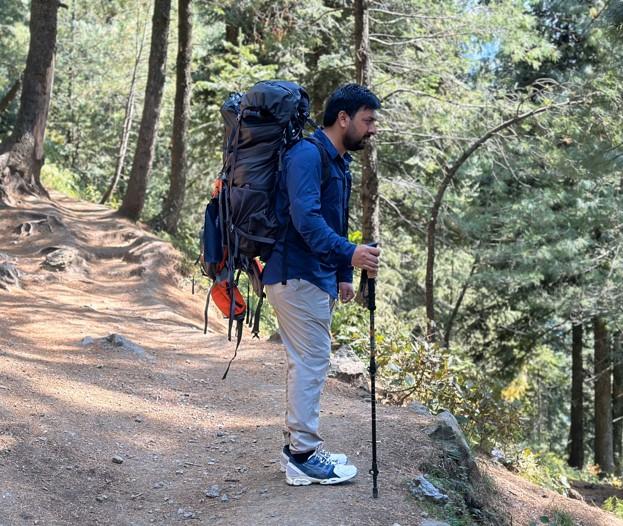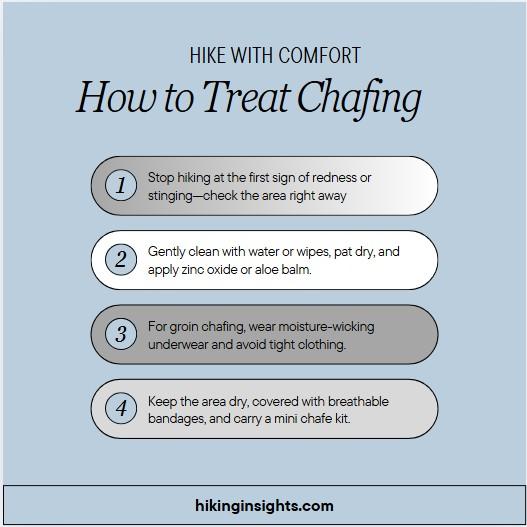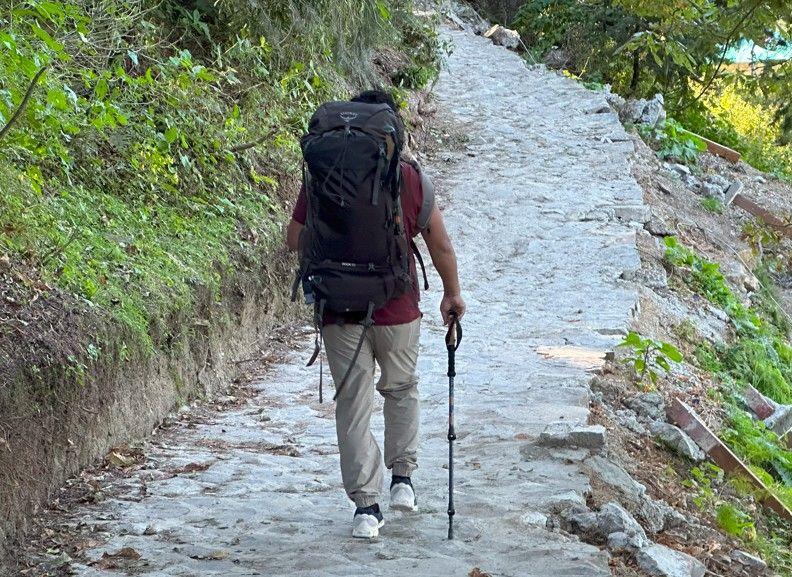As a long-term hiker, I’ve faced chafing on my expeditions. Even experienced hikers ask themselves questions like how do I stop my inner thigh from chafing when I walk? or how to prevent chafing when hiking as a female when wearing a skirt.
Painful skin irritation may derail a hike, but you can prevent it with the right strategies.
What is Chafing?
Chafing is a type of skin damage caused by repeated friction. It usually shows as a painful rash. In some cases, you also experience bleeding or cracked skin. The skin may feel raw and sore to the touch. Mild chafing usually heals quickly.
What Causes Chafing While Hiking
Chafing happens due to constant friction. It typically occurs in spots like the groin, underarms, and inner thighs. In my experience, coarse fabrics and uneven seams increase the problem. Sweat or rain also raises the level of friction.

Since repeated movements cause chafing, it becomes a serious concern on longer hikes. I noticed that ill-fitted gear and clothing also increases chaffing irritation. If ignored, these small areas can turn into painful blisters or even open wounds that might cut your hike short.
Where Should You Expect Chafing on a Hike?
Hikers should be aware of high-risk areas to monitor early signs of discomfort and act fast. On longer hikes, I noticed that these spots are especially at risk for chafing:
- Inner thighs
- Underarms
- Groin
- Under the bra line
- Waistline
- Feet
- Shoulders
Sweat also builds up in skin folds, which raises the risk of irritation. Both men and women often experience chafing in the groin and buttocks area. If you’re wondering how to stop bum chafing when walking, I recommend investing in well-made, breathable clothing.
How to Prevent Chafing While Hiking
Choose the Right Clothing
Your clothing can make or break a hike. Cotton is bad for hiking, so it’s best to avoid it. Personally, I swapped cotton for moisture-wicking fabrics. I go with synthetic materials like polyester and wool to stay comfortable on the trail. I also noticed a drop in irritation once I switched to synthetic base layers and merino wool socks.
Seamless or flat-seam underwear also helps reduce skin friction. Supportive shorts or fitted tights work well too, especially if you’re wondering how to stop chafing between the thighs for guys. For women, this also lowers the risk of thigh chafing when wearing dresses or hiking skirts.
Stay Dry on the Trail
Fabrics that wick away sweat will help stop thigh chafing while walking. They also keep you dry in different weather conditions. I recommend packing an extra pair of socks and underwear, especially for longer trips.
I always change my socks after walking through wet conditions. This simple habit has saved me from painful chafing on multi-day hikes. Quick-dry towels and wipes are also handy for removing sweat from key areas.
Fit Your Gear Properly
Badly fitted gear is one of the top causes of hiking chafing, especially on long treks. I always adjust my backpack so it stays snug without shifting. I also suggest using quality hiking belts and chest straps to distribute weight evenly and avoid rubbing.
Make sure straps don’t dig into your skin or bunch up your clothing. Add padding to areas that tend to rub, like the hips and shoulders. Check your gear’s fit regularly during breaks.
Apply Anti-Chafing Products
Whether you’re trying to prevent chafing while hiking as a male or as a female, you’ll need the right products. Apply Body Glide or a similar balm to the shoulders, waistline, underarms, groin, and inner thighs.
Use hiking chafing cream or anti-chafing cream on the thighs and feet. For sensitive areas like the groin, try best anti-chafing gel.
Anti-chafing sticks don’t add weight to your gear and are easy to reapply. If you need a cheaper option, zinc oxide or petroleum jelly provide lasting protection.
For humid areas, bring chafing powder to reduce moisture. Many new hikers think that moisturizing can stop chafing. From my experience, it keeps your skin soft but doesn’t stop friction.
How to Treat Chafing
If you start feeling any irritation or soreness, take a break to check the affected area. Clean the skin gently with antiseptic wipes or water. Pat the area dry and apply a zinc oxide cream or petroleum jelly to protect it.
What is the fastest way to heal chafing? Keep the skin clean, dry, and shielded from more rubbing. Use breathable bandages to cover the area. For mild cases, over-the-counter balms with aloe or zinc can help speed healing.

How to treat chafing in the groin area? First, clean the skin and apply a zinc-based cream or chafing gel. Wear moisture-wicking underwear and avoid tight-fitting clothes. If you see bleeding or signs of infection, seek medical help.
Conclusion
Learning how to prevent chafing while hiking can seriously boost your performance on the trail. Chafing can derail even the best-planned hikes, but with smart prevention and quick treatment, you’ll stay moving. Choose the right clothing, keep your skin dry, and ensure your gear fits properly. Use creams, gels, or balms as needed—and enjoy longer, more comfortable hikes.
FAQs
How to Avoid Chafing on a Hike?
Select moisture-wicking clothes and compression anti-chafing shorts specifically designed for hiking. Apply hiking chafing cream or anti-chafing gel to the thighs, groin, and underarms.
What is the Quickest Way to Stop Chafing?
At the first sign of friction, pause the hike and clean the area. Pat dry and apply petroleum jelly or zinc oxide cream. Cover open skin with breathable bandages and use anti-chafing gel for fast relief.
How to Walk Long Distances Without Chafing?
I always test anti-chafing products during training walks, so I know what works before hitting longer trails. I use merino wool socks, seamless underwear and moisture-wicking base layers. Quick-dry towels and powders also help stay dry.
How to Stop Bum Chafing When Walking?
Select underwear with wide, soft waistbands. Use thin and breathable liners beneath anti-chafing shorts, especially if you’re prone to heat buildup. Avoid sitting on rough surfaces, as this may aggravate more sensitive skin. Use a high-quality, quick-dry towel if you get sweaty.
How to Stop Legs Rubbing Together When Walking?
Apply anti-chafing balm to your thighs. Wear proper hiking shorts to prevent skin contact. If you experience any discomfort during your hike, dry the area and apply another coat of anti-chafing cream.
